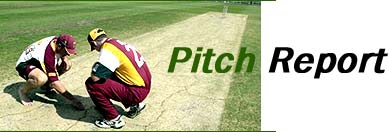 | « Back to article | Print this article |

Punjab Cricket Association
Date of inspection: 15 September 2002
Present: I S Bindra (President)
M P Pandove (Hon Secretary)
Dalit Singh (Curator)
Kasturi Rangan (BCCI-Chairman of Pitch and Grounds)
Bill Walmsley (NZ Sports Turf Institute)
Present condition of ground
A very impressive ground and facilities maintained in first class order. The three center pitches have been re-laid and look to be progressive well. Two outer pitches were cultivated and resown. Outfield is smooth and well irrigated. Block is level and well grassed. Purple nutsedge is being hand weeded. The first test match was held at this ground in 1994.
Prospects for sporting pitches
The soil mixture used in the pitch is 1 part of red soil to 5 parts of black soil. The mixture has been provisionally assessed as a light brown silt, type B (Appendix 2).
It will be interesting to compare the performance of this soil with the dark brown/black soils, type C. It looks to be a soil that will compact easily without the need for very heavy rollers, but achieving moisture penetration of the compacted soil and decompaction may be more difficult than with other soils. I am encouraged to hear that the soil does readily absorb water from hand watering. I wonder if a soil of higher clay content, could not be found locally? I know the pitch is already considered & lively one, but one should never stop looking for better soils if they were available.
I look forward to hearing what pitch preparation programme works best with this soil.
Limitations on producing a quality outfield
The Jacobsen Tri-King triplex mower will only mow to a minimum height of 9.5 mm, according to the manufacturer's data. It would be best to replace it with a `golf greens mower' type triplex mower. Alternatively equip with three or four walk-behind outfield mowers so the outfield can be mown in the required time (Appendix 7)
I would prefer to see the Jacobsen Greens King pedestrian mower kept as a dedicated cricket square mower, and not used on the outfield at all.
The stadium has its own deep well for supplying irrigation water which is stored in two 40,000 litre tanks. There is a very good `big gun' bayonet sprinkler system that allows the outfield to be irrigated in 45 minutes.
The block is irrigated by hand-hosing.
The current irrigation system looks to be adequate, provided it applies water uniformly.
Urea is applied in solution through the irrigation system. Apply nitrogen fertilizer (urea) as lightly and frequently as possible. Apply half the rate suggested for dry fertilization at twice the frequency per year (Appendix 5)
Equipment limitations
There does not appear to be any equipment limitations, unless the Association chooses to update the walk behind outfield mowers with three or four new models.
There is a good range of cricket pitch rollers and sponge rollers (Supersoppers).
It would be desirable to apply liquid pesticides through a boom sprayer, rather than a single nozzle knapsack sprayer.
If hand-raking does not adequately control thatch and fibre, then consider purchasing a scarifying machine. The more nitrogen fertilizer applied to produce a dense green outfield, the more scarifying is needed to prevent if becoming thatchy and puffy.
Organisation limitations to producing a high quality cricket venue
Superb organization here. A model for others to follow.